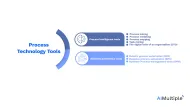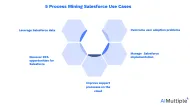3 Steps to Implement RPA with Robotic Process Mining in 2024
RPA can decrease costs and errors by 25-60% while allowing employees to engage in higher value-added activities, improving employee and customer satisfaction by 62%. This is why 64% of enterprises have started implementing RPA. Despite the growing interest in RPA, business leaders face numerous challenges when choosing a process to automate. Operations can be problematic in implementing RPA because they include:
- Low-value added tasks and activities
- High-level cognitive tasks
- Sub-processes with numerous tasks and activities
Robotic process mining (RPM), also known as task mining, overcomes such pitfalls by automatically discovering activities and detecting tasks for further improvement and automation.
This article will explain RPM and how it can enable business leaders to succeed in their RPA projects.
What is robotic process mining?
Robotic process mining, also called task mining or task intelligence, refers to techniques and tools that collect and analyze user interaction data while executing user-driven tasks. User-driven tasks involve interactions between users and software applications. For example, if an employee (user) clicks on a web application to edit a file, RPM captures these clicks.
After identifying the tasks to automate, business automation teams spend some time to look for ways to automate these tasks. Automatic bot generation can help shorten this time by automatically translating the user behavior recordings into a RPA script.
RPM enables process automation in three stages:
1. Collect and clean data
RPM captures the user activities as UI logs. UI logs include events that are executed for one or more tasks by a user in a given time. For example selecting a field in a form, editing it and opening an application or Web page. These activities are recorded through some extensions or plugins and then merged into a raw UI log.
UI log data specifies these activities based on the event type, timestamp, origin and other information, such as the labels for buttons, as Table 1 illustrates. Once the data is collected, RPM tools identify and filter events that are irrelevant to any action and should not be automated.
Table 1
Source: Robotic Process Mining: Vision and Challenges
2. Detect best tasks for RPA
RPM discovers repetitive sequences of actions executed by users to complete the tasks. Once the routines are discovered, RPM identifies the ones that can be automated by evaluating the execution frequency and length of the routines.
For example, customer reps pull all records of a customer to help them regarding their recent payment issue. RPM can discover the routines the customer reps do to pull and understand these records before solving the issue. The tool then can pinpoint the specific activities that can be replicated by an RPA bot.
3. Implement RPA
Once RPM detects the candidate routines for automation, it digs into analyzing the activation conditions of these routines. It looks for specifications and time that triggers the routine and performance of the routine. It maps the actions based on these specifications and then generates an executable RPA script.
The RPA bot performs the routine when the specified conditions are met. During this phase, users can stop the execution of the bot to make small corrections if needed. Otherwise, the bot replaces the manual work.
Figure 1 illustrates how robotic process mining enables RPA implementation in three steps. RPM identifies the routines that users execute, determines the tasks that are candidates for automation, and automates the tasks by recognising the patterns and specifications.
Figure 1
Source: Robotic Process Mining: Vision and Challenges
How to choose an RPM vendor?
One challenge business leaders and analysts may face is that they often get lost among process intelligence tools. Leading process mining vendors leverage ML and other AI applications, known as intelligent process mining, or offer task mining capabilities along with process mining to provide a more profound understanding of business operations. Therefore, business leaders and analysts can benefit from RPM through such process mining tools.
Further reading
Explore more on benefits and use cases of process mining and task mining, and differences between these two solutions:
- Top Use Cases and Applications of Process Mining
- 3 Reasons to Apply Task Mining
- 3 Ways to Distinguish Task Mining and Process Mining
If you want to benefit from task mining or process mining but do not know where to start, review our data-driven vendor lists.
Assess different vendors with a transparent methodology yourself by downloading our checklist:
And, if you still have questions, let us help you:



Comments
Your email address will not be published. All fields are required.